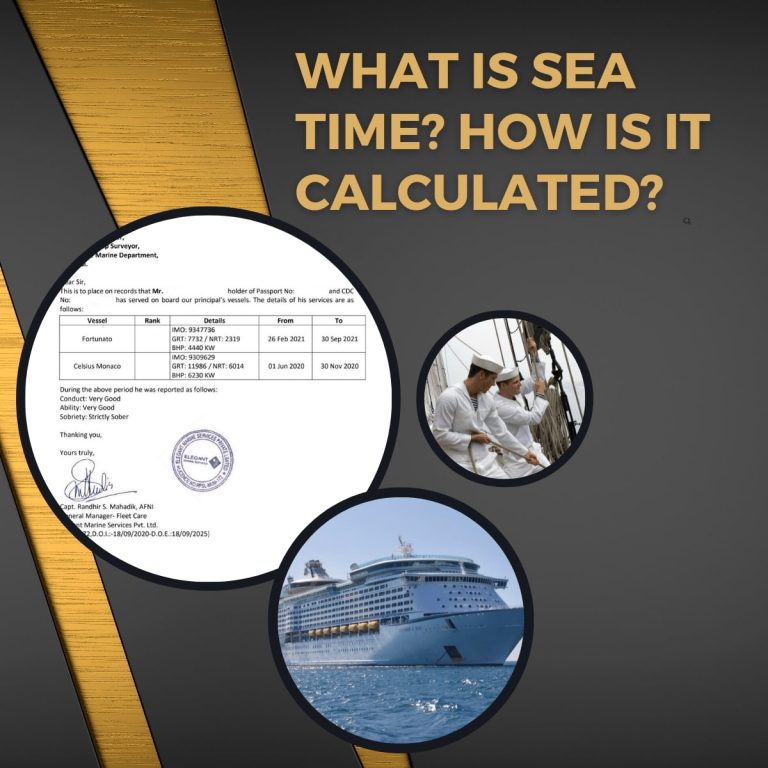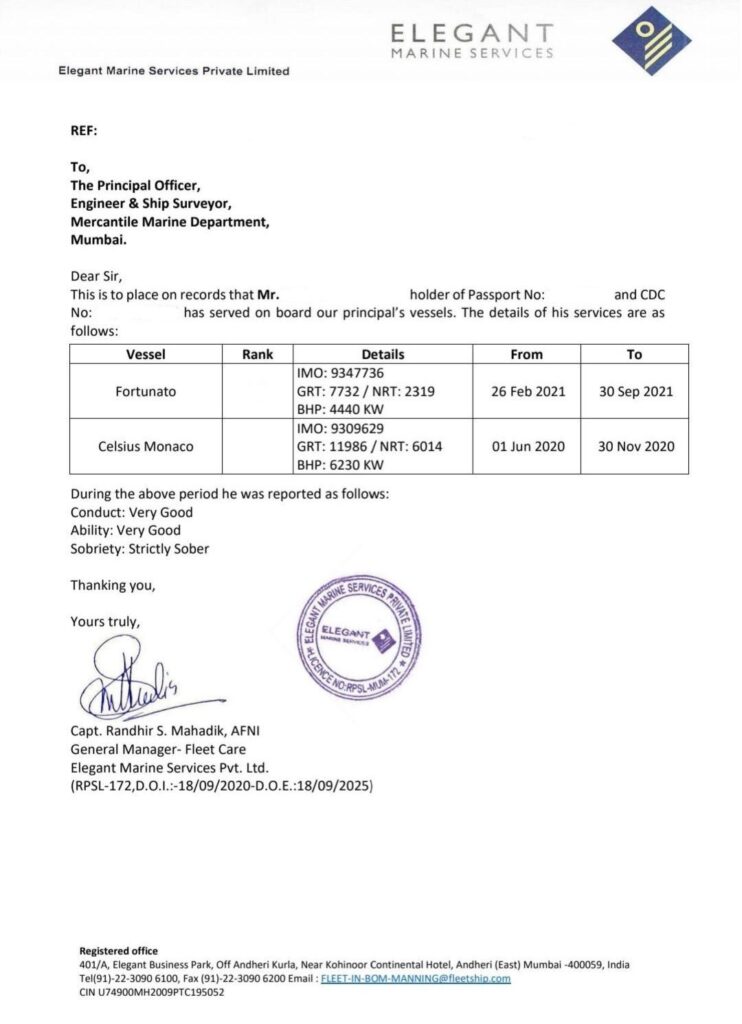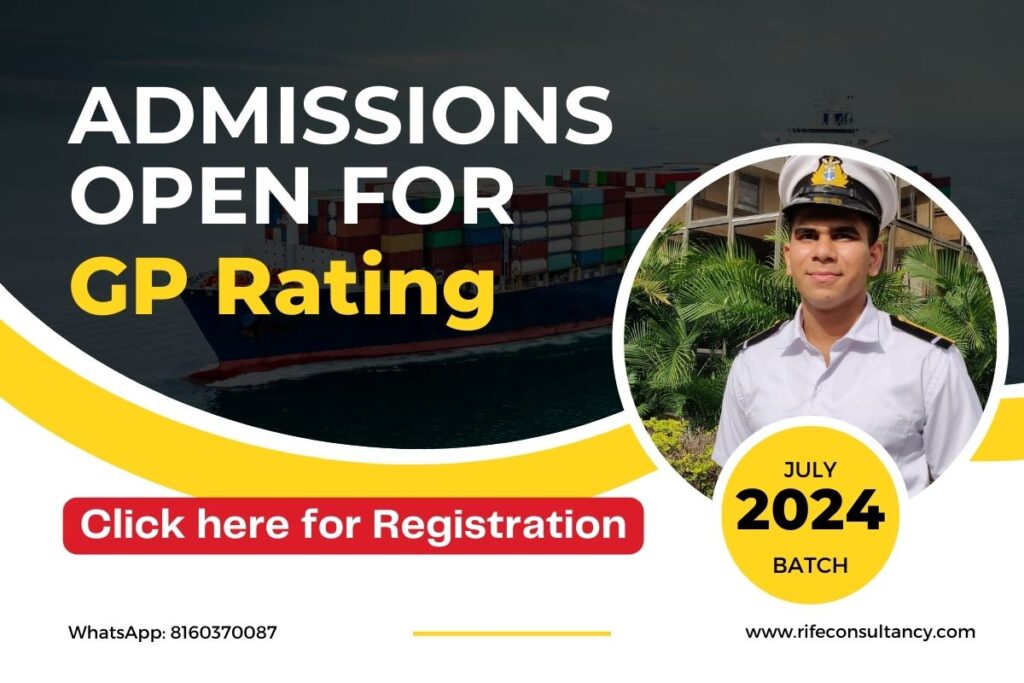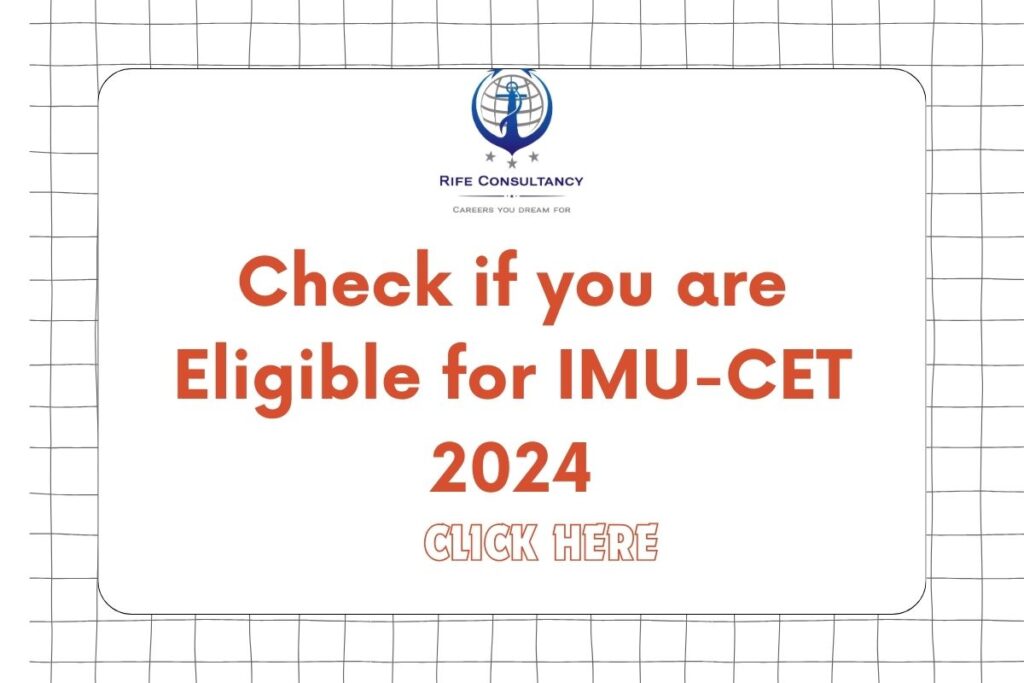
What is Sea Time? How is it Calculated?: Merchant Navy Guide
If you are a seafarer or aspiring to join the merchant navy, you might have heard the term ‘Sea time’ a lot of times. In this blog, we will discuss the meaning of sea time, how it is calculated, and why it is important in a seafarer’s career.
Table of Contents
Let’s get started.
What is Sea Time?
A seafarer’s professional career is heavily reliant on the concept of sea time. The term “Sea Time” refers to all of the time spent working on a ship at sea that is actively sailing for cargo transportation and is not the complete amount of time a seafarer spends at sea (that also includes time at the port).
Depending on the minimum qualification criteria, which are determined in accordance with the STCW 2010 guidelines, the sea time requirements for seafarers may vary from one country to another.
The term “Sea Time” refers to a document that the department head (chief engineer and ship captain) gives to a seafarer to confirm that they have sailed onboard the vessel for a specific amount of time. The paper contains information about the ship, such as its name, IMO number, tonnage, engine specifications, etc.
The sea time certificate also includes comments on the seafarer’s conduct and professionalism for the period spent at sea. The document must include the official seal of the ship and the master’s signature to demonstrate its authenticity. The seafarer should gather and retain all of their Sea Time Certificates because the company and the exam officer will require them for the Certificate of Competency Exams.
The Sea Time certificate is similar to the experience letter that people receive on land for their employment. However, the sea time letter must be obtained on each ship before signing off or when the department head signs off. Thus, the number of sea time certificates that you can obtain depends upon the number of sailings.
Why is Sea Time Important?
When a seafarer changes shipping companies or ships, the chain of command that governs ship operations will remain the same, which distinguishes the merchant navy from other occupations.
Additionally, as a seafarer, you are constantly thinking about and preparing for your next promotion, and after passing an exam for a certificate of competency, a person working onboard a vessel might actually obtain endorsement as an officer of higher rank by an approved government authority.
A minimum amount of sea service must be completed before taking these tests; the amount of time depends on your rank and the COC you’re looking for. The “Company’s Matrix System” is the common name for the promotion criteria used by shipping companies, which call for candidates to complete specified sea time on a particular position.
According to the agreement between the firm and the seafarer, after the Sea Time is reached and depending on one’s performance, the company will award promotion either on the next ship or onboard the same ship.
If you have been working with the same firm for a long period, they will have a record of your sea time in their official system. However, if you decide to change companies, these sea time certifications will come in helpful to demonstrate that you have sufficient work experience in a specific role.
As a seafarer advances in his or her career, he or she must take numerous beginner and intermediate courses. To be eligible to apply for these courses, you must have a specific sea experience as determined by the sea time certificate.
Before boarding the ship, for example, basic STCW courses such as basic fire fighting must be completed. However, advanced fire fighting can be done if a candidate has sea time, which means that the person has been on a ship and has some knowledge of onboard systems.
How is Sea Time Calculated?
As soon as the seafarer boards the ship and hands over the documents, which includes the COC (for officers) and the seafarer identification certificate, the master will stamp it with the remark indicating the individual has joined the ship in a specific rank or role.
As a result, the sea time calculation will begin on the date of stamping. Different countries’ sea time requirements and calculating methodologies may differ. In the United States, for example, sea time is determined in days, which encompasses all days the seafarer stayed onboard the ship until the last contract, including the day not worked at all. That is, until the final sign-off.
The criteria for India and Australia watchkeeping certificates is specified in “Number of Months.” As a result, the Sea Time certificate will record the time spent on board in either days or months, depending on the nationality of the seafarer and the COC chosen.
If a ship is in a dry dock or laid up for an extended length of time with no voyages, those days will still be counted toward the sea certificate if the duration of the dry dock or laid up is less than two months. A sea time certificate will be issued to such candidates onboard by the Master.
In accordance with the Sea Time Document, a day of work entails eight hours of assigned or watchkeeping tasks. Overtime is not counted against this. Many government agencies, including the USCG and AMSA, also stipulate that the sea time will be counted as 1 day plus one-half day of service credit if the person works 12 hours on a ship in a day.
On a ship, it is customary to state the sea service time in months or years. And then, if necessary, convert it to days. In order to make things simpler, a year at sea is equal to 360 days, and a month is equal to 30 days.
Also Read: 3 Types of Hazard on Ship: Operational, Security & Safety
Things Included in Sea Time Certificate
Each business may use a different template to provide seafarers with their certificates of sea time. The document may be accompanied by the original discharge documentation from the company. However, the certificate’s content should include some essential information that must be present in all sea time certificates. The following details can be seen on a sea service certificate:
- Name and official number of the ship
- Date of service i.e. from sign in to sign off
- Total number of days worked on a ship
- Gross tonnage of the Ship
- Engine Type and Specification including Horsepower
- If the ship is sailing on coastal and inland routes, specify the number of days sailed in coastal, inland, or river waterways.
- The average number of hours worked per day
- Description of duties performed onboard
- Brief Specification of Watchkeeping duties
- Professional behavior onboard ship
Below is an example of a sea service certificate:

Different Sea Time Requirements on Ship
One aspect of climbing the ship’s hierarchical ladder is accumulating sea time with a sea time certificate. The other is passing competitive exams by fulfilling the requirements utilizing your sea time certificates.
A sea time certificate enables a deck rating, such as an ordinary seaman, to gain experience day by day and take an exam in order to work their way up to become a shipmaster. An ordinary seaman must spend 36 months at sea or, in some cases, 24 months if they have completed a structured onboard training program and TRB, in order to become a certified officer of a foreign going vessel.
Similar to this, a cadet who has completed a DNS course must have 18 months at sea, and a cadet with a BSc in nautical science must have 12 months at sea in order to earn a 2nd Mate FG certificate.
A 2nd mate must have an additional 18 months of sea duty in order to be eligible to take the exam for a Certificate of Competency of Chief Mate. A chief officer must have at least 12 months of chief officer experience in addition to a verified 36 months of seagoing duty in order to become a master.
The aforementioned criteria are for an Indian COC for a 500GT foreign-going ship.
Similar to this, an engine room cadet must have completed six months of sea experience in order to sit for the exam for a fourth engineer officer on a ship capable of sailing abroad and equipped with a 750KW main propulsion engine.
The fourth engineer becomes qualified to administer the COC test for Class II officer engineer or second engineer after completing a 12-month sea service. A 2nd engineer officer must have 36 months of seagoing service with at least 12 of those months spent in the post of 2nd Engineer officer on ships with main propulsion machinery rated at 3000 kW or higher in order to be eligible to become the ship’s Chief Engineer.
Checkout the below table for understanding the assessment of sea service performed in non-trading vessels operating in foreign/Indian coastal waters towards 2nd mate certification:
| Sr. No. | Course | Approved Sea-going service required for 2nd Mate FG examination | Conditions to be met if the sea-going service includes Non-trading ships |
| 1 | B.Sc in Nautical Science | 12 months | Minimum of 6 months must be performed on trading vessels |
| 2 | B.Sc. Polyvalent course | 18 months (12 months on deck + 6 months in E/R) | Minimum of 9 months must be performed on trading vessels |
| 3 | Diploma in Nautical science | 18 months | Minimum of 9 months must be performed on trading vessels |
| 4 | Science/ Engg. graduate entry scheme | 15 months | Minimum of 7.5 months must be performed on trading vessels |
| 5 | GP Rating | 36 months or 24 months | Minimum of 18 months (12 months with SSTP) must be performed on trading vessels |
| 6 | Other Deck cadets | 36 months or 24 months | Minimum of 18 months (12 months with DLP) must be performed on trading vessels |
Calculation of Qualifying Sea-going service for Second Mate (FG) certification if the service includes Non-trading ships
| Ship Type | Size | Rate of calculation for sea time assessment | For Illustration:Actual Sea service performed | Qualifying Sea going Service |
| Foreign going trading ships | 500 GT or more | Full Rate(META Manual Section M-II/11) | 12 months | 12 months |
| Trading Ships engaged on near coastal voyages of 500 miles or more | 500 GT or more | Full Rate(META Manual Section M-II/11) | 12 months | 12 months |
| Trading Ships engaged on near coastal voyages of less than 500 miles | 500 GT or more | 2/3 rd Rate(META Manual Section M-II/11) | 9 months | 9 x 2/3 = 6 months |
| Non-Trading vessels like OSV’s, Cable laying ships, AHTS, Dredgers, Diving Vessels, Survey vessels, SPS ships etc, operating in foreign waters | 3000 GT or more | First six months at full rate and further service at 2/3rd rate | 9 months | 6 + 3 x 2/3 = (6 + 2)= 8 months |
| Non-Trading vessels like OSV’s, Cable laying ships, AHTS, Dredgers, Diving Vessels, Survey vessels, SPS ships etc, operating in foreign waters | 500 GT or more but less than 3000 GT | First six months at 2/3rd rate and further service at half (1/2) rate. | 9 months | 6 x 2/3 + 3 x 1/2 = (4 + 1.5) = 5.5 months |
| Non-Trading vessels like OSV’s, Cable laying ships, AHTS, Dredgers, Diving Vessels, Survey vessels, SPS ships etc, operating in Indian coastal waters | 3000 GT or more | Maximum of four months at 2/3rd rate | 6 months | 6 x 2/3 = 4 months |
| Non-Trading vessels like OSV’s, Cable laying ships, AHTS, Dredgers, Diving Vessels, Survey vessels, SPS ships etc, operating in Indian coastal waters | 500 GT or more but less than 3000 GT | Maximum of four months at half (½) rate | 8 months | 8 x 1/2 = 4 months |
Also Read: 14 Things to Know and Carry Before Joining a Ship
Click here to join our Telegram chanel
You will get information, news, and support related to Merchant Navy.



